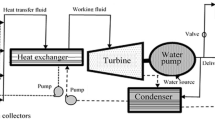Abstract
Solar water pumping systems are considered one of the best solutions especially in rural and isolated areas where the traditional sources of power (electricity or diesel) are unavailable or very costly. It represents a clean source of energy, available with abundant quantities with very good average daily solar radiation of about 5.5 kW h/m2/day. The present work provides a comprehensive study for a complete design of the solar pumping system components with different water demands. A computer program is designed and developed to offer the system design and the solar simulation model is presented. The hydraulic power, photovoltaic (PV) peak power, PV required area, and total system costs for different total dynamic heads and different water demands ranged from 1–1000 m3/day are calculated. The present research is a good tool for designers, users, and buyers of such systems. It is found that the PV solar water pumping system is more economically feasible than diesel generators up to a water demand of 100 m3/day. The model is a needed tool for all concerned in the field of PV solar water pumping including costumers.

















Similar content being viewed by others
REFERENCES
Raturi, A., Feasibility study of a solar water pumping system, Appl. Sol. Energy, 2011, vol. 47, no. 1, pp. 11–13.
Zainutdinova, Kh.K. and Lutpullaev, S.L., Solar power and the possibility of socio-economic development in the remote and mountainous areas of Uzbekistan, Appl. Sol. Energy, 2011, vol. 47, no. 4, pp. 327–335.
Hatem, M.A., National Specialized Board Council Reports, Vol. 1: The Arab Republic of Egypt, 1974–1989, Technical Report, 1990.
Food and Agriculture Organization of the United Nations, FAO, Aqua stat Database. 2015. http://www.fao. org/faostat/en/#search/2016%20%2F%202015-2017.
Darouich, H.M., Pedras, C.M.G., Gonçalves, J.M., and Pereira, L.S., Drip vs. surface irrigation: a comparison focusing on water saving and economic returns using multi-criteria analysis applied to cotton, Bio Syst. Eng., 2014, vol. 122, pp. 74–90.
Mohammedi, Mezzai, N., Rekioua, D., and Rekioua, T., Impact of shadow on the performances of a domestic photovoltaic pumping system incorporating an MPPT control: a case study in Bejaia, North Algeria, Energy Convers. Manage., 2014, vol. 84, pp. 20–9.
Abdalla Kishta, M., Designing, modeling, and testing a solar water pump for developing countries, Retrospective Thesis and Dissertations, State Univ., 2002, p. 391.
NRCS, Natural Resources Conservation Service, Design of small photovoltaic (PV) solar-powered water pump systems, Tech. Note, no. 28, Portland, Oregon, 2010.
Kelley, L.C., Gilbertson, E., Sheikh, A., Eppinger, S.D., and Dubowsky, S., On the feasibility of solar-powered irrigation, Renewable Sustainable Energy Rev., 2010, vol. 14, pp. 2669-2682.
Cuadros, F., Lopez-Rodriguez, F., Marcos, A., and Coello, J., A procedure to size solar-powered irrigation (photoirrigation) schemes, Sol. Energy, 2004, vol. 76, pp. 465–473.
Hamidat, Benyoucef, B., Hartani, T., Small-scale irrigation with photovoltaic water pumping system in Sahara regions, Renewable Energy, 2003, vol. 28, pp. 1081–1096.
Glasnovic, Z. and Margeta, J., A model for optimal sizing of photovoltaic irrigation water pumping systems, Sol. Energy, 2007, vol. 81, pp. 904–916.
Meier, T., Policy Recommendations to Improve the Sustainability of Rural Water Supply Systems, IEA, 2011.
Odeh Yohanis, Y.G. and Norton, B., Economic viability of photovoltaic water pumping systems, Sol. Energy, 2006, vol. 80, pp. 850–860.
Mahjoubi, Mechlouch, R.F., Mahdhaoui, B., and Brahim, A.B., Real-time analytical model for redicting the cell temperature modules, Sustainable Energy Technol. Assessm., 2014, vol. 6, pp. 93–104.
Mozaffari Niapour, S.A.K.H., Danyali, S., Sharifian, M.B.B., and Feyzi, M.R., Brushless DC motor drives supplied by PV power system based on Z‑source inverter and FL-IC MPPT controller, Energy Convers. Manage., 2011, vol. 52, pp. 3043–3059.
Fernandez-Ramos, J., Narvarte-Fernandez, L., and Poza-Saura, F., Improvement of photovoltaic pumping systems based on standard frequency converters by means of programmable logic controllers, Sol. Energy, 2010, vol. 84, pp. 101–109.
Kordzadeh, The effects of nominal power of array and system head on the operation of photovoltaic water pumping set with array surface covered by a film of water, Renewable Energy, 2010, vol. 35, pp. 1098–1102.
Ould-Amrouche, S., Rekioua, D., and Hamidat, A., Modelling photovoltaic water pumping systems and evaluation of their CO2 emissions mitigation potential, Appl. Energy, 2010, vol. 87, pp. 3451–3459.
Gad, H.E., Performance prediction of a proposed photovoltaic water pumping system at South Sinai, Egypt climate conditions, in Proceedings of the 13th International water Technology Conference, Hurghada, Egypt,2009, pp. 739–52.
Flores, C., Poza, F., and Narvarte, L., A tool to widen the possibilities of PV pumping simulation, Int. J. Sustain Energy, 2012, vol. 3, pp. 73–84.
Foster, R. and Hanley, C., Life cycle cost analysis for photovoltaic water pumping systems in Mexico, in Proceedings of the 2nd World Conference on Photovoltaic Energy Conversion, Vienna, Austria,1998.
Duffie, J.A., and Beckman, W.A., Solar Engineering of Thermal Processes, 2nd ed., Chichester: Wiley, 1991.
RETScreen Natural Resources Canada. http://www. nrcan.gc.ca/energy/software-tools/7465.
Egyptian Organization for Standards and Quality. http://www.eos.org.eg/en.
Kudela, H., Hydraulic Losses in Pipes, Wroclaw Univ. Sci. Technol., 2015. https://www.researchgate.net/ publication/265535267_Hydraulic_losses_in_pipes.
Kleissl, J., Deep-Well, Low-Flow Photovoltaic Water Pumping System Design. http://solar.ucsd.edu/nottrott/reports/Nottrott_SolarWellIrrigation.pdf.
Perakis, C., El Shenawy, E.T., El Ghetany, H.H., and Kyriakarakos, G., Design of autonomous PV/RO desalination systems case studies for Egypt and Greece.
Shinde, V.B. and Wandre, S.S., Solar photovoltaic water pumping system for irrigation: a review, Afr. J. Agricult. Res., 2015, vol. 10, no. 22, pp. 2267–2273.
Ahmad, G.E., Photovoltaic-powered rural zone family house in Egypt, Renewable Energy, 2002, vol. 26, pp. 379–390.
Meteonorm Software. http://www.meteonorm.com/en/features/features.
ACKNOWLEDGMENTS
The authors would like to acknowledge the Mechanical Engineering Department, Faculty of Engineering, Al-Azhar University, Egypt and the Solar Energy Department, National Research Centre, Egypt for providing the facilities to perform this research.
Author information
Authors and Affiliations
Corresponding author
About this article
Cite this article
Said M. A. Ibrahim, El-Ghetany, H.H. & Shabak, A.G. Comprehensive Design Tool for Sizing Solar Water Pumping System in Egypt. Appl. Sol. Energy 56, 18–29 (2020). https://doi.org/10.3103/S0003701X20010053
Received:
Revised:
Accepted:
Published:
Issue Date:
DOI: https://doi.org/10.3103/S0003701X20010053




